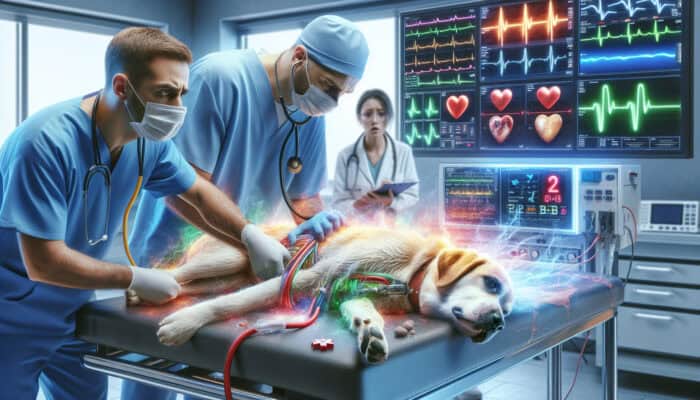Uncover the Hidden Risks in Easter Baskets That Could Endanger Your Beloved Pets
Understanding the Toxic Effects of Chocolate on Dogs and Other Pets
Chocolate is a well-known hazard for pets, particularly dogs, due to the presence of theobromine, a chemical compound that is extremely toxic to them. Even a minuscule amount can lead to serious health complications, with symptoms including vomiting, diarrhoea, heightened heart rate, and in severe instances, seizures or cardiovascular failure. During the Easter celebrations, it is crucial to ensure that all chocolate products are securely stored away from your furry friends. Common chocolate items that can pose significant risks to pet safety include:
- Chocolate bunnies
- Chocolate eggs
- Chocolate-covered nuts
- Chocolate sweets and candies
- Chocolate milk or drinks
- Chocolate truffles
- Chocolate chips
Proactively inform family members and guests about the dangers that chocolate poses to pets, thereby fostering a safer atmosphere for your cherished animals during the holiday festivities. Awareness is essential in preventing accidental poisoning and ensuring the health and safety of your furry companions throughout this celebratory period.
Identifying Plants and Flowers That Pose Toxic Risks to Pets During Easter
Easter celebrations are often adorned with beautiful floral arrangements, yet many of these plants can be extremely harmful to your pets. Specific varieties, such as lilies and daffodils, are particularly dangerous. Ingesting these plants can lead to a variety of symptoms, ranging from mild irritation to severe kidney failure, especially in cats, who are especially sensitive to the toxic effects of lilies. Exercise extreme caution by keeping these hazardous plants well out of reach of your pets. Common toxic plants often used in Easter decorations include:
- Lilies
- Daffodils
- Hyacinths
- Azaleas
- Chrysanthemums
- Rhododendrons
- Foxglove
Consider choosing pet-safe flowers or alternative decorative items that do not present any risks to your beloved animals during your Easter celebrations. By making informed decisions, you can create a festive atmosphere without compromising the safety and well-being of your furry companions.
Understanding the Dangers of Plastic and Foil Wrappers for Pets
The eye-catching and shiny wrappers surrounding Easter treats can easily attract pets; however, the ingestion of plastic or foil wrappers may lead to choking hazards and severe health problems like intestinal blockages. Pets often cannot distinguish between edible treats and these dangerous materials, making it vital to dispose of wrappers immediately and maintain a vigilant eye on the areas where Easter baskets are located. Common materials found in Easter baskets that could threaten your pets include:
- Plastic wrappers from candies
- Foil wrappers from chocolates
- Plastic grass filling
- Plastic egg shells
- Cellophane wrapping from gift items
- Bubble wrap used for packaging
Be diligent in ensuring that all wrappers are kept out of reach after the festivities conclude, as this simple action can significantly reduce the risk of health emergencies for your pets. By maintaining a clean and safe environment, you can help ensure the safety and well-being of your furry friends throughout the holiday.
Gain Essential Insights on Recognising Easter Basket Hazards for Your Pets

How to Identify Dangerous Items Concealed in Easter Baskets?
Spotting hazardous items within Easter baskets is crucial for ensuring a safe holiday for your pets. Pets are often drawn to colourful or shiny objects, which may not be safe for them. Expert analysis has revealed that many common household items can pose risks during this festive time. Items such as chocolate, certain candies, toxic plants, and plastic wrappers can entice pets, leading to the potential for ingestion. It is imperative to thoroughly inspect all contents of Easter baskets and securely store any dangerous items out of reach of curious paws.
Additionally, educate family members about these risks, reinforcing the importance of keeping a close watch on pets during these celebrations. Furthermore, consider choosing less hazardous alternatives, focusing on safe options that can bring joy without any associated risks. Awareness and proactive measures can significantly enhance the safety of your pets during the Easter festivities.
Steps to Create a Pet-Friendly Easter Basket
Assembling a pet-friendly Easter basket is not only attainable but also immensely rewarding. By carefully selecting pet-safe treats, toys, and other non-toxic items, you can ensure that your furry companions enjoy the holiday without any associated dangers. Experts suggest consulting a veterinarian for personalised recommendations that account for your pet’s specific dietary needs and play preferences.
You might consider including items such as:
- Healthy pet treats
- Durable toys made from non-toxic materials
- Stuffed animals that do not contain small parts
- Natural chews like rawhide or dental bones
- Homemade pet snacks crafted from safe ingredients
- Recyclable paper or cardboard as basket filler
These alternatives not only provide enjoyment for pets but also ensure their safety, allowing everyone to celebrate without worries. By focusing on pet-friendly options, you can create a delightful Easter experience that prioritises the health and well-being of your furry friends.
Immediate Steps to Take If Your Pet Ingests a Hazardous Item

If you suspect that your pet has ingested something harmful, taking swift action is essential. The first step is to contact your veterinarian or an emergency veterinary clinic without delay. Experts stress that time can be critical in minimising potential damage resulting from the ingestion of dangerous items.
In many instances, prompt intervention and professional guidance can lead to positive outcomes. Real-life examples demonstrate that pets who receive immediate medical attention after consuming toxic substances often recover well without lasting harm. Keep emergency contact numbers readily accessible and familiarise yourself with the signs of distress in pets, as this knowledge can empower you to respond effectively in such situations. Being prepared can facilitate a swift and effective response in case of emergencies.
Methods to Prevent Pets from Accessing Easter Baskets
To prevent accidental ingestion of harmful items, it is crucial to keep Easter baskets out of pets’ reach. Experts recommend placing baskets on high shelves or in closed rooms where pets cannot access them. Keeping these items out of sight and reach significantly diminishes the likelihood of a dangerous incident occurring during the festivities. Always take proactive measures to create a safe environment for your pets, ensuring that they can enjoy the holiday safely.
Strategies to Teach Children About Pet Safety During Easter
Educating children about the risks associated with sharing Easter basket items with pets is vital for promoting a safe celebration. Experts recommend involving kids in discussions about pet safety, emphasising the necessity of supervising all interactions between pets and basket contents. By instilling an understanding of these risks, children can learn to enjoy the holiday while also safeguarding their beloved furry friends. Creating a culture of safety and awareness can enhance the overall enjoyment of the festivities for everyone.
Proactive Measures to Prevent Accidents Related to Easter Baskets
The Importance of Continuous Supervision During Easter Celebrations
Consistent supervision of pets during Easter celebrations is crucial to prevent them from accessing hazardous items. Pets are naturally curious and may attempt to sneak into baskets when they believe no one is watching. Maintaining a vigilant eye on your pets not only deters mischief but also allows you to enjoy the festivities with peace of mind. Involve family and friends in monitoring pets, making it a collective effort to ensure a secure environment throughout the celebrations.
Establishing a designated area for pets, away from the excitement of the celebrations, can also be beneficial. Creating a safe zone filled with their favourite toys and treats can keep them entertained while minimising the risks associated with Easter baskets. This proactive approach not only enhances safety but also ensures that pets feel included in the celebrations without compromising their well-being.
How to Secure Hazardous Items Effectively
Store Easter baskets and related items in locations that pets cannot access, significantly reducing the likelihood of accidents. Utilise high shelves or locked cabinets to keep dangerous items out of reach, ensuring that your pets’ curious paws remain safe. This proactive approach can save you from potential emergencies and create a stress-free atmosphere during the holiday. By being thorough in your storage practices, you can effectively protect your pets from harm.
Consider using storage solutions such as decorative bins that blend seamlessly with your holiday décor while keeping contents secure. Regularly inspect areas where baskets are placed to ensure no hazardous items are left behind after the celebrations, maintaining a safe environment for your pets.
How to Inform Family Members About Pet Safety?
Educating everyone in your household about the dangers of Easter baskets to pets is fundamental for prevention. Involve both children and adults in discussions about the importance of keeping baskets secured and away from pets. Clear communication regarding the potential hazards associated with Easter treats, wrappers, and plants can cultivate a safer environment for your cherished animals. By fostering an open dialogue about safety, you can ensure that everyone is on the same page and vigilant during the holiday.
Establishing household rules, such as not leaving baskets unattended in pet-accessible areas, can also enhance safety. Raising awareness around these issues ensures that everyone in the home is aligned and vigilant during the holiday, contributing to a secure and enjoyable celebration for all.
How to Choose Safe Contents for Your Easter Baskets?
Opting for pet-safe treats and steering clear of toxic items is vital for a worry-free Easter celebration. Evaluate all basket contents before presenting them to your pets to ensure that no harmful items, such as chocolate or dangerous plants, are included. Selecting non-hazardous contents not only protects curious pets but also allows you to enjoy the holiday without concern. By making informed choices, you can create a festive environment that prioritises the health and safety of your furry friends.
Consider choosing alternative treats, such as fruit-infused snacks or specially formulated pet sweets, that can effectively replace traditional candy items. Providing safe and enjoyable treats enhances the festive spirit while ensuring the health and well-being of your pets, allowing everyone to celebrate together without worry.
Immediate Actions to Take Following an Incident
Knowing how to respond if your pet accesses an Easter basket is crucial for minimising harm. Keep emergency veterinary contact numbers readily accessible, and be prepared to act swiftly if an incident occurs. Stay calm and assess the situation—determine what your pet has ingested and communicate this information when seeking professional assistance. Quick and effective action can make a significant difference in the outcome of an emergency.
Having a clear action plan can be the difference between a minor scare and a serious health issue. Familiarise yourself with potential symptoms of poisoning or distress, enabling you to respond promptly and effectively should an emergency situation arise. Being prepared and knowledgeable can empower you to take the right steps to protect your pet’s health.
Recognising Symptoms of Easter Basket-Related Illness in Pets
How to Identify Gastrointestinal Symptoms in Pets?
Gastrointestinal symptoms such as vomiting, diarrhoea, or a loss of appetite may indicate that your pet has ingested something harmful. These signs can appear shortly after consumption and should prompt immediate veterinary attention. Regularly monitoring your pet’s behaviour and eating habits during the Easter holiday can assist in detecting potential issues early. Awareness of these symptoms can help you act quickly if your pet’s health is compromised.
Being proactive and observant is essential. If you notice any gastrointestinal distress after your pet has had access to Easter basket items, do not hesitate to take action. This vigilance can save your pet from more severe health complications down the line, ensuring their well-being during the festive season.
Recognising Neurological Symptoms in Pets
Signs such as lethargy, tremors, or seizures can indicate serious poisoning from Easter basket items. If a pet displays neurological symptoms, immediate veterinary care is necessary, as these conditions can escalate swiftly and lead to severe health issues. Recognising these signs early is critical in ensuring your pet receives the necessary treatment. By being attentive to your pet’s behaviour, you can catch potential issues before they become emergencies.
Be vigilant in monitoring your pet’s behaviour, particularly after they have been near potentially harmful items. If any concerning symptoms arise, acting quickly can be vital in preventing long-term damage and ensuring your pet’s health and safety.
How to Identify Allergic Reactions in Pets?
Allergic reactions can occur due to certain Easter basket contents, presenting as swelling, itching, or breathing difficulties. These responses can vary in severity, making it important to monitor your pet closely during the holiday. Recognising early signs of allergies can facilitate timely intervention, which may be crucial for your pet’s health. By being aware of potential allergens, you can take steps to protect your pets from harm.
If you suspect your pet is experiencing an allergic reaction, consult with a veterinarian immediately. Understanding potential triggers can also help avoid similar situations in the future, ensuring a safe and enjoyable Easter celebration for all your furry friends.
Behavioral Changes That May Signal Distress in Pets
Unusual behaviours in pets, such as excessive whining, hiding, or aggression, may indicate discomfort or illness caused by Easter basket items. These changes can be subtle but often serve as indicators that something is wrong. Closely monitoring your pet and noting any shifts in behaviour can provide critical information to your veterinary care provider if the need arises. By being attentive, you can catch potential issues early.
If you observe persistent changes in behaviour, do not hesitate to seek professional advice. Identifying issues early can lead to better outcomes and a healthier, happier pet, allowing you to enjoy the holiday celebrations with peace of mind.
Effective Strategies to Minimise Easter Basket Risks for Pets
Crafting Pet-Safe Easter Baskets
Assembling Easter baskets that are safe for pets is not only achievable but essential. Start by selecting non-toxic items to include in your baskets. Consider using pet-safe treats and durable toys that won’t pose a choking hazard. Avoid items with small parts or toxic materials, and remember that even seemingly harmless items can be dangerous. By focusing on safety, you can create a joyful experience for your furry friends.
Experts recommend using baskets with lids to keep contents secure from curious noses and paws. This simple yet effective measure not only enhances safety but also adds an element of surprise for your pets when they discover their new goodies. Ensuring their safety should always be a priority while crafting a delightful Easter experience.
Steps to Take After Easter Celebrations
Properly disposing of or storing Easter basket items after the holiday is critical in preventing pet accidents. Once the festivities are over, take the time to ensure that all hazardous items, such as leftover chocolates, wrappers, and decorations, are safely out of reach. This proactive step helps maintain a safe environment for your pets long after the celebrations have concluded.
Experts advocate conducting a thorough cleanup to protect pets. This may involve checking all areas where Easter items were displayed or stored, ensuring that nothing is left behind that could pose a risk. By being diligent, you can help ensure your pets remain safe and healthy during the holiday season and beyond.
Utilising storage solutions that keep leftover items contained and secure can also enhance safety. Consider repurposing or recycling Easter basket materials to eliminate potential hazards, making the cleanup process both safe and eco-friendly. Being conscientious about post-holiday practices is essential for maintaining a secure environment for your furry companions.
Training Your Pet to Stay Away from Easter Baskets
Training your pet to avoid Easter baskets is a vital part of ensuring their safety during the holiday. By employing positive reinforcement techniques, you can effectively teach your pet to stay away from baskets containing tempting items. Use commands such as “leave it” or “no” when they approach the basket to instil good behaviours.
Reward them with treats or praise to reinforce desired behaviours. Experts recommend consistent training sessions before and during the holiday to ensure that your pet understands the expectations. This proactive approach helps create a safer Easter for both pets and their families, ultimately enhancing the experience for everyone involved.
Understanding the Risks for Different Types of Pets During Easter
Why Dogs Are Particularly Vulnerable to Easter Basket Items
Dogs are especially at risk from the dangers of chocolate and other toxic items commonly found in Easter baskets. Chocolate represents a significant threat to dogs, as it can lead to severe symptoms including hyperactivity, vomiting, and potentially fatal heart problems. Being mindful of your dog’s behaviour and ensuring that hazardous items are kept well out of reach is essential for a safe celebration. Preventative measures can greatly enhance your dog’s safety during the holiday.
Additionally, consider the other treats available. Many candies can also be harmful to dogs, making it crucial to thoroughly evaluate the entire contents of the basket. Vigilance and proactive measures can help safeguard your furry friends during this festive time, allowing you to enjoy the holiday without worry.
Potential Risks for Cats from Easter Basket Contents
Cats may find certain plants or small decorative items in Easter baskets intriguing, which can pose health risks. For instance, lilies are highly toxic to cats and can lead to severe kidney failure. It is essential to securely store all plants and small objects away from areas where cats can access them. By being vigilant, you can prevent potential health hazards and ensure a safe environment for your feline companions.
Moreover, be aware that cats can endanger themselves by chewing on plastic or foil wrappers, leading to choking hazards or intestinal blockages. By ensuring that any potentially dangerous items are removed from their environment, you can create a safer holiday atmosphere for your furry friends while allowing them to participate in the festivities.
Ensuring Safety for Small Animals During Easter
Small animals, such as rabbits, guinea pigs, and similar creatures, can also be affected by items found in Easter baskets, particularly plastic and foil. These small pets may chew on or swallow hazardous materials, leading to choking or intestinal blockages. To protect small animals, ensure that Easter baskets are completely out of their reach. Creating a safe, designated area with appropriate toys and treats for these animals can enhance their enjoyment during the holidays while keeping them away from potential dangers.
By taking these precautions, you can ensure that all pets, regardless of size, are safe and secure during the Easter celebrations, allowing everyone to enjoy the festivities without worry.
Essential Items to Include in Your Pet First Aid Kit for Easter
Incorporating Critical Medications for Emergencies
Including essential medications in your pet’s first aid kit is crucial for emergency preparedness. For example, activated charcoal is commonly used to assist in cases of poisoning by absorbing toxins. However, it is vital to consult a veterinarian before administering any medication to ensure proper usage and dosage. Being informed can help you make the right choices in urgent situations.
Additionally, maintaining a well-stocked kit with other medications tailored to your pet’s health needs can provide peace of mind during emergencies. Regularly check the contents of your first aid kit to ensure medications are up to date and easily accessible, allowing you to act swiftly when necessary.
Keeping Emergency Contact Information Handy
Having your veterinarian’s phone number and the contact details for the nearest emergency clinic readily accessible is essential. Quick access to professional help can significantly influence emergency situations. Ensure these numbers are kept in a visible location, such as on your refrigerator or saved in your mobile device for easy retrieval. Being prepared can make a significant difference in ensuring your pet’s safety during emergencies.
Also, consider having contact information for animal poison control centres on hand. Familiarising yourself with these resources can provide additional support in crises involving potential toxic ingestion, ensuring that you can respond effectively to any situation that may arise.
Basic First Aid Supplies to Include for Pets
Your pet’s first aid kit should contain essential supplies such as gauze, bandages, and a thermometer. These items can assist you in managing minor injuries or monitoring your pet’s condition until you can reach a veterinarian. Being prepared with the right tools can make a significant difference in emergency care.
Regularly check the kit to ensure it is replenished and organised, allowing for quick access when necessary. Being prepared with basic first aid supplies can help you provide immediate care, which may be critical in urgent situations where every second counts.
Staying Informed About Hazardous Easter Items
Being aware of dangerous items, including chocolate, lilies, and specific foods that are toxic to pets, is vital for ensuring a safe Easter celebration. Keep these items securely out of reach during the festivities to minimise any risk of accidental ingestion. Education is key, so ensure that everyone involved in the celebration understands the dangers and practices vigilance regarding hazardous items. This level of awareness can significantly enhance the safety of your pets during the holiday.
Recognising and Responding to Pet Emergencies During Easter
Immediate Actions to Take in a Crisis
If you suspect your pet has ingested something harmful, it is critical to act quickly to minimise damage. Contact your veterinarian or an emergency clinic immediately. Avoid inducing vomiting unless specifically instructed by a professional, as this can sometimes exacerbate the situation. Quick response can greatly influence the outcome of the emergency.
Gather information about what your pet ingested and any observed symptoms, as this will assist the vet in providing the appropriate care. Being prepared for emergencies by knowing the necessary steps can significantly improve outcomes for pets in distress, ensuring they receive timely and effective treatment.
Monitoring Your Pet’s Condition After Potential Ingestion
Keep a close watch on your pet’s symptoms and behaviour following the potential ingestion of harmful items. Observing any changes in behaviour, appetite, or physical condition can provide vital information for veterinary treatment. By being attentive, you can catch potential health issues early.
Being observant of your pet’s well-being during and after the holiday can help in identifying potential health issues early. Should symptoms arise, promptly seeking veterinary care can be critical in ensuring your pet’s health and safety, allowing them to recover swiftly.
When to Seek Professional Help for Your Pet
Understanding when to seek immediate veterinary care for your pet during Easter is crucial. If your pet exhibits severe symptoms, such as difficulty breathing, seizures, or loss of consciousness, do not hesitate to seek professional assistance. Being vigilant and proactive can save your pet’s life in critical situations.
Even if symptoms appear mild, it is always wise to err on the side of caution. If you are uncertain about your pet’s condition or if any unusual behaviour persists, contacting a veterinarian can provide you with the reassurance and guidance needed to ensure your pet’s health. Being informed and prepared is the best way to protect your furry friends during the holiday.
Tips for a Safe and Enjoyable Easter Celebration for Pets
Planning Ahead for Pet Safety
Planning ahead is vital to ensuring your Easter celebrations are safe for pets. Consider potential hazards and how to mitigate them. This might include establishing boundaries for where pets are allowed during festivities or preparing pet-safe alternatives for your decorations and treats. By being proactive, you can create a festive environment that prioritises the health and safety of your furry friends.
Taking steps to protect your pets can enhance everyone’s enjoyment of the holiday. By being mindful of their environment and keeping hazardous items secure, you can create a safe and joyous Easter celebration for everyone involved. Ensuring the safety of your pets can lead to a more enjoyable and worry-free experience for all.
Frequently Asked Questions About Pet Safety During Easter
Which Common Easter Items Are Dangerous for Pets?
Common items such as chocolate, toxic plants like lilies, and plastic or foil wrappers can pose serious risks to pets during Easter celebrations. Awareness of these dangers is crucial for keeping pets safe.
What Should I Do If My Pet Consumes Chocolate?
If your pet ingests chocolate, contact your veterinarian immediately for guidance on the necessary next steps. Time is critical in minimising potential harm, so swift action is essential.
Are All Easter Plants Safe for Pets?
No, many common Easter plants are toxic to pets. Lilies and daffodils are particularly harmful to cats, while other flowers can also pose risks. Always check before bringing plants into your home.
How Can I Create a Pet-Safe Easter Basket?
Choose non-toxic treats and toys, and avoid harmful items like chocolate and small parts. Consider using baskets with lids to keep contents secure and out of reach.
What Are the Signs of Pet Poisoning?
Signs of poisoning can include vomiting, diarrhoea, lethargy, tremors, and seizures. If you observe any of these symptoms, seek immediate veterinary care for your pet’s safety.
Can Small Animals Also Be Affected by Easter Basket Items?
Yes, small animals, including rabbits and guinea pigs, can be impacted by items like plastic wrappers, which can pose choking hazards or lead to intestinal blockages. Protecting small pets is essential during the holiday.
How Can I Train My Pet to Avoid Easter Baskets?
Use positive reinforcement techniques to train your pet to stay away from baskets. Commands like “leave it” combined with rewards can reinforce desired behaviour, helping to keep them safe.
Should I Keep a First Aid Kit for My Pets?
Yes, having a first aid kit for your pets is essential. Include basic supplies, medications, and emergency contact information for quick access during emergencies. Being prepared can save lives.
What Should I Do If My Pet Has an Allergic Reaction?
If you suspect your pet is having an allergic reaction, monitor their symptoms closely and contact your veterinarian for immediate guidance. Timely intervention is crucial for their health.
How Can I Educate My Children About Pet Safety During Easter?
Teach children the dangers of sharing Easter basket items with pets and supervise all interactions. Emphasising safety can help foster awareness and protect pets during the holiday.
Connect with us on Facebook!
The Article Easter Basket Hazards for Pets: Keeping Your Furry Friends Safe First Published On https://elgatoencasa.com
The Article Easter Basket Hazards: Protecting Your Pets Safely Was Found On https://limitsofstrategy.com


